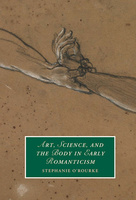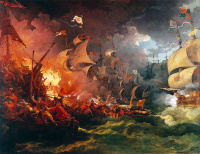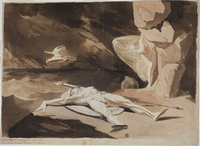Art, Science, and the Body in Early Romanticism by Stephanie O’Rourke
Reviewed by Matthew C. HunterMatthew C. Hunter
Department of Art History and Communication Studies, McGill University
Email the author: matthew.hunter3[at]mcgill.ca
Citation: Matthew C. Hunter, book review of Art, Science, and the Body in Early Romanticism by Stephanie O’Rourke, Nineteenth-Century Art Worldwide 21, no. 3 (Autumn 2022), https://doi.org/10.29411/ncaw.2022.21.3.19.
This work is licensed under a Creative Commons Attribution-NonCommercial 4.0 International License  unless otherwise noted.
unless otherwise noted.
Your browser will either open the file, download it to a folder, or display a dialog with options.

Stephanie O’Rourke,
Art, Science, and the Body in Early Romanticism.
New York: Cambridge University Press, 2022.
Cambridge Studies in Romanticism.
253 pp.; 32 color and 17 b&w illus.; bibliography, notes, index.
$99.99 (hardcover)
ISBN: 978–1–316–51902–8
Stephanie O’Rourke’s Art, Science, and the Body in Early Romanticism is an exemplary book. The text centers around three artists and their engagements with “sciences” of uneven repute at the turn of the nineteenth century. Writing in a lively, engaging prose, O’Rourke examines the paintings of Philippe-Jacques de Loutherbourg through the prism of the artist’s interlude as medical healer using the principles of Franz Anton Mesmer’s “animal magnetism.” A second chapter considers Henry Fuseli’s paintings and graphic work via Johann Caspar Lavater’s physiognomic theories; a third interprets the art of Anne-Louis Girodet Trioson in light of his interest in electricity. The book’s introduction provides a masterful synthesis of recent historiography of Romantic art and social history of science. Amply illustrated with numerous color images and framed by a substantial concluding chapter, the book presents a capstone vision of how histories of art and science can be told together.
Many routes are available for plotting contacts between visual art and the sciences. O’Rourke makes clear that she is not claiming the paintings and drawings under investigation as depictions of historical knowledge-practices (17–19). Nor does the book attempt to count these major, international artists as scientists. The aim is not to make historians of science recognize, say, Girodet’s contribution to electrical research.[1] Equally, while few specifics of de Loutherbourg’s healing techniques are provided, O’Rourke is not seeking to recuperate the painter into histories of medical science. Instead, accenting the traffic from historical knowledge-fields into visual culture, the book seeks to illuminate the larger conditions of knowing shared between art, medicine, and science broadly conceived. O’Rourke’s central thesis is that, seen through their various knowledge-entanglements, de Loutherbourg, Fuseli, and Girodet reveal a crisis of Enlightenment thought bearing on the authority of the human body and the reliability of its sensory reports experienced circa 1800.
Experienced where? Much recent research on art of the long eighteenth century has aimed to decenter Europe as the locus of critical attention. As in many other subfields, scholars have highlighted the fundamental contingency of European art’s subjects of representation, its materials, and its conditions of possibility with enslaved, coerced, or otherwise exploited labor.[2] Germane to O’Rourke’s focus on the body, those conversations are, the book acknowledges, only passingly present. Instead, the story is split between Britain and France with occasional excursions to Rome—itself a welcome integration given the persistence with which national boundaries continue to shape scholarship, particularly in studies of British art.
If the location is then generally northern-European, the book’s plot is essentially Biblical. From possession of “a self-continuous, self-identical body; a body whose cognitive experience adequately reflected a material reality; a body whose cognitive experience was causally linked to sensory stimulus” (178), all of which is attributed by the author to the Enlightenment, Romantic Europe fell. It lost not only confidence in the expressive powers of the heroic male body privileged in neoclassical art academies, but a broader belief in the reliability of the senses as Adamic naivety slipped into Schillerian sentiment. These general contours will be familiar to readers in art history acquainted with recent historiography of science. As in Pamela H. Smith’s widely read The Body of the Artisan, O’Rourke narrates movement from the body as site of knowledge to an eclipse of its authority.[3] As does Smith’s story, Art, Science, and the Body in Early Romanticism aligns with political chronology. Smith’s “artisanal epistemology” is evacuated of its epistemic force at the rise of crown-sponsored scientific academies in the 1660s, the moment in which seventeenth-century Europe’s venerable “crisis of authority” was broken on the model of absolutism.[4] O’Rourke’s crisis falls around 1800, broadly coinciding with the French Revolution—that venerable breaker of time—and the end of Foucault’s Classical episteme.[5] However, where the bulk of Smith’s analysis centers on Renaissance makers who asserted bodily experience as knowledge capable of rivaling scientia rooted in ancient texts, O’Rourke’s protagonists can only gaze at or disfigure the epistemically invested body with increasing, ironic distance.
Art history has contributed significant narratives of this sort. The epochal conception of art as product of an embodied human self engineered by Albrecht Dürer circa 1500, as Joseph Leo Koerner has brilliantly argued, was systematically disfigured by his follower Hans Baldung Grien whose art “subverts the humanist regimen of visual representation with its clear and bounded categories of artist, model, image, and viewer.”[6] Like Koerner (who has also worked in dialogue with the history of science and written memorably on Romantic art), O’Rourke builds her disfiguration story by drawing significantly from formal analysis.[7] Each of the three main chapters opens with a “set piece” analysis of a painting by the artist under investigation. Penned with fluent prose and packed with ingenious insights, these analyses provide evidence that O’Rourke complements through appeals to period response (chiefly, contemporaneous art criticism published in newspapers), printed scientific texts, and secondary scholarship. No archival manuscripts are cited directly.
For a book centrally invested in the body as site of knowing, some further methodological reflection on the epistemology of formal analysis would be welcome. By that I don’t only mean reckoning with the subject-position, media technics, and disciplinary formations by which present-day responses to Romantic art become historical insights.[8] More, reflecting on how the sentient body experiences art, makes claims about it, and attaches evidentiary status to those assertions could prompt greater engagement with aesthetics, a domain largely absent from the book. By the lights of Enlightenment/Romantic aesthetic discourses, were material features of objects and physiological sensations caused by them taken to be fundamental to the experience of art? Did affective, embodied responses to art need to be conveyed to the student of art’s history by descriptive language and visual reproductions? The latter is suggested in the writings of the period’s disciplinary linchpin, Johann Joachim Winckelmann. Consider Winckelmann’s early evocation of the Laocoön group, as rendered into English in 1767 by the subject of O’Rourke’s second chapter, Henry Fuseli:
‘Tis in the face of Laocoon this soul shines with full lustre, not confined however to the face, amidst the most violent sufferings. Pangs piercing every muscle, every laboring nerve; pangs which we almost feel ourselves, while we consider—not the face, nor the most expressive parts—only the belly contracted by excruciating pains: these however, I say, exert not themselves with violence, either in the face or gesture. He pierces not heaven, like the Laocoon of Virgil; his mouth is rather open to discharge an anxious overloaded groan . . . the struggling body and the supporting mind exert themselves with equal strength, nay balance all the frame. Laocoon suffers, but suffers like the Philoctetes of Sophocles: we weeping feel his pains, but wish for the hero’s strength to support his misery.[9]
Or, contrary to this kind of somatic pathos, are bodily sensations in fact irrelevant to the aesthetic, which is to be a matter of purely cognitive reflection per Kant in the Third Critique? With numerous public-facing outlets, extensive imbrication in period medical research, and thorough political saturation, aesthetics would seem to be a rich historical archive with which to amplify and to test the book’s propositions about Romantic art, science, and the body.

To my reading, the analysis consequently works best when the author treats the agents with patient flexibility and a lightness of touch. The stand-out chapter in this regard is O’Rourke’s account of de Loutherbourg. Attentive to pictorial form and facture alike, the chapter ably traces the Alsatian artist’s peripatetic career from early Parisian success and infamy into London’s visual cultures of spectacle.[10] O’Rourke allows de Loutherbourg’s engagement with Mesmeric healing to be both direct and more atmospheric. She offers several routes through which painting, healing, and spectacle might be seen to mutually inform one another, while resisting the impulse to push the point too far. Exemplary here is the chapter’s reading of Defeat of the Spanish Armada, 8 August 1588 (fig. 1), which de Loutherbourg showed at the Royal Academy’s spring exhibition in 1796. Drawing from formal analysis, O’Rourke notes the key role played by red and green, which “in addition to being complementary colors, form positive afterimages of each other . . . if one stares at a bright red or green display for several seconds and looks away one will briefly see red where green had been and vice versa” (50). Proposing that de Loutherbourg could have gained insight into these optical phenomena from his experience producing theatrical effects at David Garrick’s Drury Lane theater and his own Eidophusikon, O’Rourke wields impressive restraint. She acknowledges the limits of the available evidence and the modes of conjecture required to square the painting’s perceptible features with the Mesmeric effects noted by period observers of de Loutherbourg’s paintings (45). The chapter provides compelling insights and opens exciting interpretive possibilities without forcing the issue.

Less successful are passages such as the chapter on Fuseli where the privileged relations are pressed too rigidly. Consider the chapter’s account of Thetis Mourning the Body of Achilles (fig. 2), a wash drawing by Fuseli dated to 1780, now in the collection of the Art Institute of Chicago. “Achilles’s facial features,” O’Rourke contends, “are characteristically obscured by dramatic foreshortening. He appears, moreover, to lack both eyes and ears. Yet his torso swells with densely clustered parcels of shaded musculature. They emerge and recede as if retaining some of Achilles’s essential vitality” (91). The author calls attention to this composition and its “frenzied musculature” to highlight the problems they present to the knowledge-claims of Johann Caspar Lavater’s physiognomy. As is standard in the historiography, Fuseli and Lavater had known each other from youth in 1740s Zurich. Over several disagreement-filled decades, Fuseli contributed preparatory drawings for Lavater’s print-heavy publications, volumes that privileged crisp graphic forms and clear rendering of bodily structures. Such is the context in which O’Rourke frames the Achilles drawing. The claim is that for Fuseli to efface such bodily structures—to hide Achilles’s face, to render his dead body in a manner whereby “the viewer’s eye practically vibrates as it glides over its tessellated forms” (91)—was to split appearance and reality apart. Through the drawing, Fuseli voices “a note of deep skepticism about the scientific viability of a physiognomic enterprise” (91).
Yet, Fuseli’s art is nothing if not over-determined. The chapter makes no comment on the setting in which dead Achilles and Thetis appear, but water is essential to it. Choppy waves, diagonal slashes of wash suggestive of cloud-bursting rain: these occupy at least a quarter of this large (16 x 22 in.) drawing. A poetics of water, as has observed Barbara Maria Stafford (a scholar whose imprint looms large in this book), performs significant work in the conception of the body in Winckelmann, that writer whose work Fuseli had translated in 1767.[11] When using wash to render the stormy sea and the “swelling torso” of a hero dead for want of means to fully dip his body into the immortalizing waters of the River Styx, might Fuseli not have been thinking back to Winckelmann? My point is not to insist that Winckelmann was indeed Fuseli’s guiding reference; it is to suggest that a Winckelmannian conception of the body seems as potentially relevant to this wash drawing as does Lavater. A more capacious openness to what the drawing’s manifold figures of embodiment might reveal—or, barring that, some greater patience in expositing why a break from the Lavaterian project must command attention supremely—would be welcome.
Nearly forty years ago, Svetlana Alpers delivered a controversial account of art at a junction with the natural sciences. Alpers appealed to the optical research of Johannes Kepler; she looked to instruments and visualizations produced at the early Royal Society of London. Embracing Foucauldian chronology, Alpers’s The Art of Describing also tied Rieglian formalism and some venerable art-historical preoccupations (i.e. modes of vision to the north and south of the Alps) with the then-recent language of visual culture.[12] The Art of Describing would go on to inform foundational works in the sociology of scientific knowledge (SSK) and science and technology studies (STS) while exemplifying what many art-historical contributions to “art/science” conversations have aimed to do in the decades since.[13] Art, Science and the Body in Early Romanticism prompts reflection on why and for whom such conversations have mattered, and what they might do next.
Notes
[1] The book’s assertion is that scant evidence bearing on Girodet’s electrical knowledge survives. Little is said on details such as the dates of Girodet’s pedagogy in electricity or the possible chronology of electrical tropes in his posthumously published writings; see 109–13, 207; 139.
[2] Some examples include: Jennifer L. Anderson, Mahogany: The Costs of Luxury in Early America (Cambridge, MA.: Harvard University Press, 2012); Daniela Bleichmar and Meredith Martin, eds., Objects in Motion in the Early Modern World, Art History Book Series (Chichester: John Wiley & Sons, 2016); Sarah Betzer and Dipti Khera, eds., “The ‘Long’ Eighteenth Century?” Journal18, no. 12 (Fall 2021), https://www.journal18.org/past-issues/12-the-long-18th-century-fall-2021/.
[3] Pamela H. Smith, The Body of the Artisan: Art and Experience in the Scientific Revolution (Chicago: University of Chicago Press, 2004).
[4] Theodore K. Rabb, The Struggle for Stability in Early Modern Europe (New York: Oxford University Press, 1975).
[5] See Michel Foucault, The Order of Things: An Archaeology of the Human Sciences (Routledge Classics. London: Routledge, 2002), esp. 235–40; originally published as Les mots et les choses: une archéologie des sciences humaines (Paris: Gallimard, 1966).
[6] Joseph Leo Koerner, The Moment of Self-Portraiture in German Renaissance Art (Chicago: University of Chicago Press, 1993), 444. Other notable disfiguration narratives might include Louis Marin, Détruire la Peinture (Paris: Editions Galilée, 1977); and Michael Fried, Realism, Writing, Disfiguration: On Thomas Eakins and Stephen Crane (Chicago: University of Chicago Press, 1987).
[7] See for example his contribution to Lorraine Daston, ed., Things That Talk: Object Lessons from Art and Science (New York: Zone Books, 2004); and Joseph Leo Koerner, Caspar David Friedrich and the Subject of Landscape, 2nd ed. (London: Reaktion Books, 2009).
[8] Instructive approaches here include: Zeynep Çelik Alexander, Kinaesthetic Knowing: Aesthetics, Epistemology, Modern Design (Chicago: University of Chicago Press, 2018); Harry Francis Mallgrave and Eleftherios Ikonomou, Empathy, Form, and Space: Problems in German Aesthetics, 1873–1893 (Santa Monica, CA: Getty Center for the History of Art and the Humanities, 1994).
[9] J. J. Winckelmann, Reflections on the Painting and Sculpture of the Greeks . . . Second Edition, trans. Henry Fusseli [sic] (London: Printed for A. Millar and T. Cadell in the Strand, 1767), 30–1.
[10] Note, for example, O’Rourke’s keen observations on de Loutherbourg’s counter-intuitive technique of using thick impastos to render atmospheric effects and thin paint films to represent rocky substantiality; 38–9.
[11] Barbara Maria Stafford, “Beauty of the Invisible: Winckelmann and the Aesthetics of Imperceptibility,” Zeitschrift für Kunstgeschichte 43, no. 1 (1980): 65–78. See also Martin Kemp, “Some Reflections on Watery Metaphors in Winckelmann, David, and Ingres,” Burlington Magazine 110, no. 782 (1968): 266–72.
[12] Svetlana Alpers, The Art of Describing: Dutch Art in the Seventeenth Century (Chicago: University of Chicago Press, 1983).
[13] Note, for example, the prominent positions given to The Art of Describing in key SSK/STS texts such as Steven Shapin and Simon Schaffer, Leviathan and the Air-Pump: Hobbes, Boyle, and the Experimental Life (Princeton, NJ: Princeton University Press, 1985); and Bruno Latour, “Drawing Things Together,” in Representation in Scientific Practice, eds. Michael Lynch and Steve Woolgar (Cambridge, MA: MIT Press, 1990), 19–68.